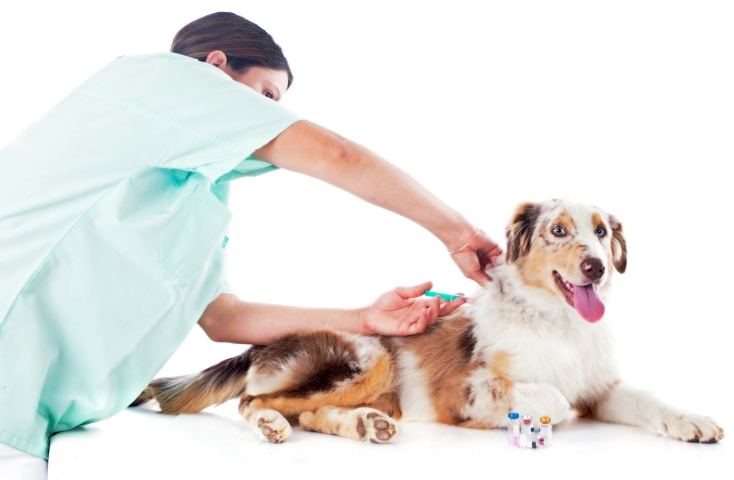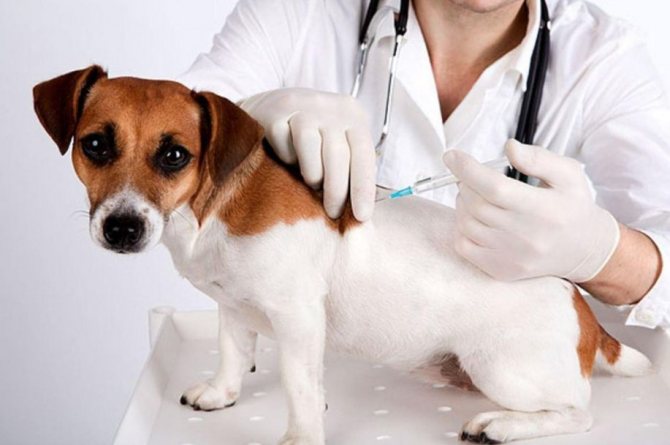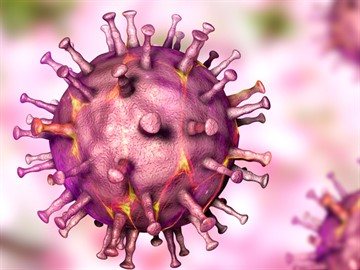Distemper in dogs: first signs, symptoms and treatment at home
Distemper (Pestis) is a highly contagious viral disease characterized by fever, intoxication, damage to the skin and mucous membranes, respiratory and digestive organs in dogs. In some cases, it causes severe manifestations of meningitis and encephalitis.
Distemper has been known since the domestication of dogs. In the writings of Aristotle it is described as a sore throat. In Russia, it appeared in 1762 in Crimea and was called the “Crimean disease.” The viral nature of the plague was first proven in 1905 by the French scientist Carré (Carré disease).
Causes of plague
The main reason is infection with a dangerous, highly contagious virus.
The causative agent of plague is an RNA virus from the paramyxovirus family (canine morbillivirus).
Properties of the virus
The properties of this virus include:
- The virus is not stable in the external environment. In nasal discharge and feces of sick animals, it loses activity after 7-11 days.
- Dried or frozen virus lasts for several months, and in a lyophilized state - for at least a year. Heating to 60°C destroys it in 30 minutes, to 100°C - instantly.
- Disinfectants and physical factors deactivate the virus quite quickly: 1% and a solution of Lysol and ultraviolet rays - in 30 minutes, 2% and a solution of caustic soda - 60 minutes, sunlight and 0.1-0.5% solutions of formalin and phenol - through few hours.
Animals most susceptible to infection
The disease in the form of an epizootic (epidemic in animals) occurs throughout the world. Silver-black foxes, arctic foxes, Ussuri raccoons, ferrets, sables, bears, weasels, stoats, and wolves are susceptible.
Maternal antibodies, detected in colostrum and milk, create passive immunity in puppies up to the age of 1.5-2 weeks, but not always. Those who have recovered from plague have long-lasting immunity, but it is not sterile and not necessarily lifelong.
Even immunized animals lose resistance to distemper as a result of prolonged stress, immunosuppression, or contact with an openly sick animal.
Which dogs are at risk?
More often, the generalized form occurs in unvaccinated dogs , especially in puppies 8-16 weeks of age with impaired colostral (obtained from the mother's colostrum) immunity.
Short-faced animals get sick less often than long-faced ones. Almost all dogs suffer from distemper in one form or another, but more often it occurs in puppyhood.
Is it transmitted to humans?
Many people may have a question: Is canine distemper transmitted to humans?
The answer is simple - a person cannot become infected with distemper, no matter what form the dog gets sick with. The plague causative virus is absolutely not dangerous to the human body, so you should only worry about the health of the animal and that it can infect other pets.
Where can you get infected? Sources of plague
The source of infection is an infected animal
, which releases the virus into the external environment, the virus is contained in discharge from the eyes and nose, in exhaled air, saliva, feces and urine for 10-51 days.
Factors of transmission of the virus include contaminated animal care items, clothing, food, insects, birds and rodents. The latter are not only mechanical carriers, but also secrete the virus without showing signs of disease.
The reservoir of the virus pathogen in nature is wild animals and stray dogs. The disease occurs at any time of the year and manifests itself epizootically or sporadically.
Symptoms and signs of distemper in dogs
The incubation period (the moment the virus enters the body before the first signs of distemper appear) in a dog lasts 3-21 days or more, sometimes 60-90 days. With the development of animal immunity, the clinical picture of distemper has changed significantly in recent years.
Previously, distemper in dogs occurred in clinically pronounced forms with fever and intoxication, but recently atypical forms have been more often recorded or the disease occurs in conjunction with other infectious diseases.
In the early stages (3-5 days) the disease is characterized by:
- weakness and lethargy
- poor digestion
- bilateral (on both sides) serous, serous-purulent conjunctivitis;
- in the morning or during the day, the eyelashes are glued together with pus (white, gray or greenish), it is difficult to open the eyes;
- severe photophobia appears.
- dogs go into the shade, hide under a closet, bed or table, and strive for a cool place.
In parallel or later (after 3-5 days) the following develops:
- rhinothea (profuse nasal discharge);
- dry cough, which becomes wet after 5-7 days, especially with timely treatment;
- nasal discharge is clear, cloudy or greenish in color.
Forms of plague and course of the disease
Depending on the severity of the clinical symptoms of plague, several types of plague are conventionally distinguished:
| Types of plague | ||
| Form | Symptoms | |
| Skin | The appearance of red spots with signs of inflamed skin, as well as ulcers and pus. The mildest form of distemper, but if proper treatment is not carried out in time, there is a high risk of death of the dog. | |
| Intestinal (gastrointestinal) | It manifests itself as serious damage to the digestive system, including acute gastroenteritis, and is accompanied by refusal to feed, vomiting, as well as constipation and diarrhea, which leads to dehydration and rapid exhaustion of the dog. Feces contain a lot of mucus, often mixed with blood. | |
| Pulmonary (respiratory) | It is characterized by severe damage to the respiratory system: first the upper and then the lower respiratory tract. In this case, rhinitis, tracheitis, bronchitis, pneumonia or their mixed forms (acute catarrh of the upper respiratory tract, tracheobronchitis, bronchopneumonia) consistently develop. | |
| Nervous | The most severe form of distemper in dogs . The prognosis is often unfavorable. Serious complications include meningitis, encephalitis, meningoencephalitis, myelitis, paresis and paralysis of the limbs and sphincters of internal organs, as well as epilepsy. They develop as a result of the introduction of a virus into the cells of the spinal cord, brain and its membranes. Symptoms appear 2-6 weeks after infection. In weakened and immunized dogs, these symptoms can occur suddenly, without prior development of symptoms of general intoxication, high fever, etc. | |
| Mixed (generalized) | The generalized form occurs in 90-95% of cases of dog disease. It includes clinical symptoms of cutaneous, pulmonary, intestinal and nervous forms. The division into these forms of plague is conditional. | |
The development of one form or another is largely determined by the reactivity of the dog’s body. The same strain of the pathogen causes different clinical signs, ranging from a temperature reaction to nervous symptoms.
Also, in addition to the severity of clinical symptoms, plague can be divided according to the speed and method of the disease. The following forms of the disease are distinguished:
- Lightning fast. With a lightning-fast course, there are no obvious signs of the disease, the death of the animal occurs within one day.
- Spicy. In acute cases, a sharp increase in body temperature to 39.5 - 41 ° C is noted, especially in the evenings or at night. Appetite is distorted, but most often decreases, and at high temperatures completely disappears. Thirst increases. A comatose state develops, in which the dog or puppy dies on the 27th day of the disease.
- Subacute. Characterized by high fever that lasts from one day to two weeks. Then the fever becomes mild. In puppies 1-1.5 months of age, the temperature rises slightly or remains within normal limits. Along with fever, sick dogs exhibit depression, lethargy, muscle tremors, fearfulness, loss of appetite, dryness and roughness of the nasal mucosa. In rare cases, hardening of the paw pads may occur.
- Chronic. Most often characteristic of cutaneous and nervous forms. At the same time, in recovered animals, convulsive twitching of individual muscle groups, cuts and paralysis, as well as blindness, deafness, loss of smell, scars on the cornea, overgrowth of the pupil or atrophy of the eyeball, epilepsy remain for a long time, often for life.
- Abortive form. With a benign course, the clinical symptoms of plague are practically erased and often go unnoticed.
A good example is that a dog has a nervous form of distemper.
Laika vaccination schedule
Before the dog is one year old, it should receive several vaccinations. They are fully displayed in the table below.
| Age indicator | Disease | Note |
| 8 to 12 weeks | Parvovirus enteritis, leptospirosis, canine distemper, infectious hepatitis | The first vaccine is being made |
| 11-15 weeks | Parvovirus enteritis, leptospirosis, canine distemper, infectious hepatitis | Revaccination |
| 11–15 weeks | Rabies | Primary immunization. If the puppy was kept in greenhouse conditions, it is advisable to postpone vaccination until the teeth change. |
| From 9 months to 1 year | Parvovirus enteritis | This is the puppy's last vaccine, the next one is given a year later. |
| 9–12 months | Rabies | The last childhood vaccination, the next one is carried out a year later. |
Read Causes of abscess in dogs, signs and methods of treatment
It is worth considering that the data in the table is conditional; it may vary depending on the place and living conditions, the puppy’s health condition and viral diseases present in a certain region.
Diagnosis of canine distemper
The diagnosis of distemper in an animal is made on the basis of epidemiological data, clinical signs, pathological changes and laboratory test results.
To make a diagnosis based on clinical signs, the veterinarian takes into account the following criteria::
- Damage to the respiratory organs;
- Catarrhal gastroenteritis (inflammation of the mucous membrane of the stomach and intestines)
- Catarrh of the mucous membranes of the eyes and nose with serous or purulent discharge;
- Hyperkeratosis of the paw pads, fingers, nose and entire skin with the formation of a large amount of dandruff;
- Damage to the central nervous system with convulsions, epilepsy, paresis, paralysis, meningitis and meningoencephalitis.
If any four or five of these signs are noticed in a dog, then they indicate the occurrence of distemper. Based on two of the listed signs, a disease can be suspected, and based on three, a clinical diagnosis can be made.
Treatment of distemper in dogs
Timely veterinary care is of great importance in the treatment of this disease. It must be comprehensive. If you suspect distemper in an animal, the right decision is to call a veterinarian at home.
Treatment against plague is carried out in several areas:
- Specific (serum, immunoglobulins),
- The use of immunostimulants and immunomodulators (immunofan, ribotan, fosprenil, etc.),
- Symptomatic: antibacterial drugs (to suppress secondary microflora),
- Cardiac, astringent drugs, vitamins, electrolytes (to relieve intoxication and dehydration), antihistamines,
- Anticonvulsants and substances that stimulate the activity of the central nervous system (Forvet, etc.)
The sick dog is placed in a separate, clean, warm, draft-free, well-insulated dark room (isolated room) with moderately humid air. Prescribe peace and quiet.
Antimicrobial drugs are widely used in complex treatment : antibiotics, sulfonamides, nitrofuran and quinoxaline derivatives. Antibiotics are used taking into account the sensitivity of the microflora to them. Carefully study contraindications for use.
In parallel with antimicrobial substances, vitamins and multivitamins are needed with food or separately. Vitamins required during recovery are ascorbic acid 2-3 times a day orally or parenterally (in the form of injections), B vitamins, which are administered subcutaneously or intramuscularly. The duration of the course of treatment is determined by the veterinarian.
To increase resistance, at the onset of the disease, it is recommended to administer polyvalent hyperimmune serum against plague subcutaneously 3 to 4 times with an interval of 12-24 hours. Injections should be done carefully, given the high allergenicity.
Safer, but no less effective, is the injection of gamma and immunoglobulin. In addition to globulins, sometimes in combination with them, interferon is prescribed parenterally or externally. The course and dose are determined by the attending veterinarian. Interferon is instilled into the nose and eyes, 1-2 drops 3-4 times a day, for a week or more.
Some veterinarians successfully use thymogen, thymalin, timoptin, gactivin, anandin, comedon and others strictly according to the instructions.
Symptomatic therapy for canine distemper is carried out depending on the symptoms of disruption of the activity of a particular internal organ or an entire system.
Nutrition during illness
Dietary food is prescribed. In this case, take into account the age and breed characteristics of the animal.
First, a fasting regime is established for up to 12-24 hours with free access to water or rehydration solutions. In a bowl of boiled water, it is advisable to add a small amount of decoctions or infusions from medicinal plants (coil rhizome, marshmallow root, string, sage leaves, oak bark, oregano, cinquefoil erect, yarrow, chamomile, calamus rhizome, licorice, chaga, St. John's wort, blueberry fruits, bird cherry, horse sorrel, flaxseed, roots and rhizomes of burnet (officinalis).
These plants have medicinal effects on the body of a sick animal - enveloping, astringent, mucous and anti-inflammatory.
For 2-3 days, a small amount of liquid (water or broth) rice or oatmeal porridge, jelly or decoction is introduced into the diet, pre-mixed with a small amount of boiled chicken or ground beef (1-2 tablespoons per dose). If the dog does not develop indigestion in the form of vomiting and diarrhea after such a dacha, then the dose of food is gradually increased.
On days 4-5, fresh low-fat lactic acid products at room temperature are added to the specified diet: yogurt, kefir, acidophilus and acidophilus milk. It is advisable to use flaxseed decoction in the diet from the first days of treatment.
On days 7-9, boiled finely chopped vegetables are introduced into the diet - carrots, cabbage, potatoes.
From the 10th day, dogs are transferred to a normal diet.
If the patient is severely malnourished, artificial feeding through the rectum with nutritious and medicinal fluids is useful. As nutrient mixtures, 2-20% glucose solutions, 0.5-1% sodium chloride solutions, Ringer's and Ringer-Locke solutions, rice, oatmeal, flaxseed decoctions, meat, chicken or beef broth, peptone with saline solution are used ( 1:10), milk and combinations of these substances.
Before administering the medicinal nutritional mixture, the rectum is emptied of contents. To do this, they do a warm cleansing enema, which relieves pain and reduces muscle tone, which is important for retaining the nutritional or medicinal component introduced into the rectum.
An effective means of maintaining fluid balance is intravenous fluids. If it is not possible to install a drip system, the veterinarian prescribes subcutaneous injections. Subcutaneous injections of large volumes are conveniently made in the area of the shoulder blade or at the withers, preferably at several points 4-6 times a day, if necessary for several days in a row.
Treatment with folk remedies
Treatment with folk remedies can only be carried out as an addition to the main course of treatment and in the early stages in a mild form. You can also try folk remedies in the treatment of distemper if, for one reason or another, it is not possible to carry out treatment under the supervision of a veterinarian (for example, there are no veterinary clinics nearby).
One of the methods was described above - these are infusions from medicinal plants (serpentine rhizome, marshmallow root, sage leaves, oak bark, oregano, yarrow, chamomile, calamus rhizome, licorice, chaga, St. John's wort, blueberries, bird cherry, sorrel). Give 1-2 glasses per day. These infusions will help remove toxins and help with the functioning of the central nervous system.
Another very popular home treatment method is a mixture of vodka and egg yolk . Take a tablespoon of vodka and 1 yolk (you can add honey), mix thoroughly and give it to the dog 2-3 times a day for 3-4 days.
It is highly not recommended to use these treatment methods without consulting a veterinarian!
Prevention and control measures
In Russia, for specific prevention, domestic vaccines are used:
- vakchum;
- EPM;
- KF-668;
- multican;
- trimevak and others.
Recently, effective and low-toxic monovalent and complex vaccines have been arriving from abroad:
- hexadogue (France);
- Vanguard (Belgium);
- kanvak (Czech Republic);
- nobivac (Holland);
- Kanlan (Canada) and others.
Puppies are vaccinated from 2-3 months of age 1-2 times a year, and after a year they are vaccinated annually. The vaccine and vaccination schedule are determined by a specific veterinarian. Sellers, owners, doctors and other categories of citizens are strictly prohibited from distemper vaccinations.
After vaccination, the puppy or dog should not be walked. Keep in quarantine for 10-14 days. Before vaccination, deworming of the animal is necessary.
During illness, disinfection must be carried out in the premises where the sick animal was located. In case of death, the room is thoroughly disinfected with a 2% sodium hydroxide solution or a clarified solution of bleach with 2% active chlorine, 3% Lysol emulsion, 2% chloramine solution or Virkon C (Slovenia), etc.
A set of measures is carried out in accordance with special instructions.
The materials are for educational purposes only and do not in any form serve as a basis for independently diagnosing and treating a dog.
If your dog gets sick with distemper, first of all, you need to consult a veterinarian.
Remember – any initiative on the part of the animal owner can cause irreparable harm to the dog’s health!
Have you ever encountered plague? Leave questions for the veterinarian in the comments.
Source
Who invented the anti-plague vaccine and when?

History has recorded that it was he who, in 1898, prepared an anti-plague vaccine in a laboratory he organized in the Indian city of Bombay, where there was a plague epidemic, first experiencing its effect on himself, which saved millions of Indians, and subsequently anti-plague vaccination spread throughout the world.
Since then, India has considered Vladimir Khavkin a national hero, and the Queen of Great Britain, since this territory was then a British colony, awarded him one of the highest orders.
Distemper in dogs

Distemper in dogs is a dangerous and common viral disease. Lack of timely treatment can lead to the death of your pet. To prevent such a situation, every owner should know how it spreads, how it manifests itself, and what can be done for prevention. It is clear and detailed about canine distemper in our article.
Causes of distemper in dogs
The development of distemper in dogs occurs for one, only reason - the penetration into the animal’s body of a highly contagious virus belonging to the paramyxovirus family. It is characterized by the following features:
- capable of very rapid reproduction;
- has a strong pathogenic effect on the body;
- can affect several organ systems at once or a specific one;
- remains active in the physiological secretions of a sick dog for a week, and under favorable conditions, even more.
Once the virus enters the animal’s body, the dog itself becomes its carrier and source of infection.
How the plague vaccine works
After vaccination, dogs' bodies develop immunity. Vaccination provides increased protection against infection. In other words, after vaccination, the animal’s body independently searches for areas with weakened infectious agents and begins to secrete antibodies, which in turn subsequently neutralize the virus. When confronted with the causative agent of plague, the immune system will not allow the development of the disease.
Read When and what vaccinations to give to puppies up to one year old (table)
There are several types of vaccines:
- monovalent - they contain antigens of one disease;
- polyvalent form immunity that resists several pathologies. Recommended for adult dogs.
Where can a dog get distemper?
A dog can become infected with distemper anywhere, even at home. The source of infection is the secretions of another animal - a carrier of the virus. The virus can enter the body of a healthy pet in two ways: through the digestive tract and the respiratory system, so almost any object poses a danger, not to mention direct contact with a sick dog. This:
- feces, discharge during estrus, saliva, etc.;
- booth, aviary;
- Bowl;
- litter and so on.
The owner himself can “bring” distemper infection into the house, for example, on shoes. Cats can transmit the virus in the same way if they walk outside but come home to spend the night.
Video about dog vaccination
Watch the video where experienced breeders give their vaccination recommendations .
Owners most often have questions regarding the timing and manufacturer of the vaccines. Also, many people are confused about the schedule of when to get vaccines. It is best to find a good veterinarian who will treat your dog and give all vaccinations. Then you can get timely and competent advice. Share your experience of vaccinating your dog.
Share
Leave a review
Mechanism of disease development
After the distemper virus has entered the animal’s body, it begins to actively multiply. The owner will not immediately determine that his pet is sick. The first days the dog is in its normal state. The latent reproduction period of the virus can be an average of a week, but sometimes two or even three. A very rare situation occurs when signs of the disease appear 2-3 days after contact between a healthy and an infected dog. This is only possible if the animal has virtually no immunity.
Note: a dog that has had distemper remains immune to the virus for life.
After the incubation period has passed and the virus has multiplied sufficiently, the first signs of the disease appear.
Vaccination scheme against plague
Vaccination should be carried out as early as possible, but not immediately after birth, after about four weeks. You will have to vaccinate several times, maintaining intervals between vaccinations.
For example, you brought home a puppy who is one month old. For the entire first month, he ate only his mother's milk and was not outside. As a rule, at this moment he is absolutely healthy.
During gestation, the fetus receives all antibodies through the placenta, and after birth - with milk. Until you are vaccinated, you should not walk with such a baby on the street. But if you really want to, then you can only do it in your arms, for no more than ten minutes.
You need to observe the puppy’s behavior for fourteen days. Monitor his health, appetite and stool, activity and sleep.

Before vaccinations, it is imperative to check the animal for the presence of worms; if there are parasites, it will tolerate vaccination less well. The first vaccination must be done at one to one and a half months.
Most often, they first vaccinate against either enteritis or hepatitis; a two-component vaccine can also be given. Pets up to six months old are given this vaccination twice in the interval from ten to fourteen days.
After vaccinations, excellent immunity appears for a period of one year. When a year has passed, vaccination must be repeated again. Vaccinations against hepatitis and enteritis are most often tolerated very easily. But until you have been vaccinated against plague, you should not walk your pet. The first plague vaccine is given at two and a half months. After vaccination, the pet must still remain at home for a month until stable immunity is developed. At this time, it is necessary to monitor the puppy’s health, not to overcool or overwork him. You don't need to bathe him either.
Initial symptoms of canine distemper
How does canine distemper manifest at the initial stage? The most common primary symptoms include:
- lethargy;
- depressed look;
- swelling and redness of the eyes;
- tousled fur;
- sensitivity to light (the dog begins to look for a darker place);
- disorders of the digestive tract;
- mucous discharge from the nose and eyes.
Not all animals exhibit these signs to the same extent. Their severity depends on the state of immunity, lifestyle, age and other factors. In addition, some symptoms of plague may predominate, or others may be added to those listed (for example, increased body temperature). It is also important which organ system is most affected by the virus.
How does the vaccine work?
When any virus enters the body, the body needs time to recognize it and turn on the immune system. An unvaccinated system does this too slowly, so the virus has time to multiply and infect vital organs.

The introduction of a vaccine allows you to form a strong immune system in advance, which will need much less time to respond, and this will maximize the protection of the dog’s health. Even if he gets sick, serious consequences can be avoided.
Currently, attenuated live vaccines are used to vaccinate against canine distemper, which allows immunity to be formed for a longer period of time than when using inactivated strains.
It is impossible to get distemper after vaccination. This only happens when the dog already has the virus in its body at the time of the procedure.
Further development of the disease: forms of plague
Symptoms of distemper in dogs are rarely observed in isolated form, since the virus affects the entire body. However, based on those that are most pronounced, several forms of the disease are conventionally distinguished.
In addition to classification according to the clinical picture, several forms of distemper in dogs are distinguished based on the duration of the disease.
- Lightning fast. Symptoms hardly appear, but the animal dies within 24 hours.
- Super acute. There is a very high temperature. The animal refuses food. Death occurs on the second or third day.
- Spicy. Characterized by the above symptoms.
- Chronic. Periods of remission alternate with relapses. The duration of the disease is up to several months.
Attention! If any deviations in the behavior or condition of the dog appear, you should immediately contact a veterinarian and get tested.
Diagnostics
After listening to complaints from the owner and examining the dog externally, the specialist will definitely prescribe laboratory diagnostics. In most cases, the study will require taking blood and swabs from the eyes (nose, mouth).
To identify a virus and determine its type, it is possible to use methods such as:
- enzyme-linked immunosorbent assay (ELISA) – allows you to detect the disease at an early stage;
- polymerase chain reaction (PCR) – also has high sensitivity;
- susceptibility test;
- tests to determine antigen in a dog’s blood;
- neutralization reaction - carried out to determine the species.
Today, there are many other laboratory diagnostic methods that can detect distemper virus in dog tissue. The choice of one method or another is within the competence of the specialist.
Treatment
Treatment of distemper in dogs should be comprehensive, including both the use of medications and additional agents. The direction of therapy depends on the clinical picture and general condition of the dog. You cannot independently prescribe medications to an animal or treat it only with traditional “proven” methods. A treatment plan for canine distemper should be drawn up by a qualified specialist.
Specific treatment
Specific methods of treating distemper in dogs include transfusion of blood into an animal from a dog that has had the plague, as well as administration of serum. The first method is rarely used, the second is the most popular. Serum is pre-treated blood taken from a dog that is already immune to the virus. Thus, it is saturated with antibodies to infection. It is administered three times, 1-2 times a day (depending on the dog’s condition). The most commonly used serums are: Gixan, Globcan, Avirocan.
However, serum administration may not always help, but only at the beginning of the development of the disease. The later the owner goes to the clinic, the less chance the pet has of recovery.
Symptomatic treatment
In each individual case, the specialist will prescribe certain medications aimed at eliminating the symptoms of the disease or preventing them. The form of medicines (tablets, injections, solutions for external treatment, etc.) is also individual. Some examples of conditions (symptoms) and medications are listed in the table below.
At the same time, taking B vitamins is indicated.
The duration of treatment for distemper in dogs is individual in each case.
Traditional methods
Along with the main treatment for distemper in dogs, it is allowed to use traditional methods, which must first be agreed with a veterinarian. For example, to accelerate the removal of toxins from the body, prevent inflammatory processes, strengthen the immune system and other purposes, you can use decoctions and infusions of medicinal plants. This could be: chamomile, motherwort, St. John's wort and so on.
Quite common is the advice on how to treat dog distemper with vodka. To do this, 100 ml of an alcoholic drink is mixed with 20 g of honey and a raw chicken egg. The mixture is stirred well and poured into the dog using a rubber bulb.
When using traditional methods and methods, the owner should not forget that the outcome of treatment is determined by the state of the pet’s immunity. If a dog has a strong immune system, then it is quite possible that it will be able to cope with the disease only with decoctions or vodka. With low immunity, such measures may not only not help, but also aggravate the situation and lead to death.
Additional measures
Treating plague at home requires taking additional measures.
- The dog should be in a clean room, on dry and regularly treated bedding.
- The bowl from which the animal eats and drinks also needs to be washed and disinfected regularly.
- Since distemper is characterized by a fear of bright light, it is better to shade the place where the pet is.
- If there are discharges or ulcers, their locations should be carefully treated with antiseptics.
You will need to pay attention not only to the location of the dog, but also to its diet. On the first day of illness, it is preferable to keep your pet on a fast for at least half a day. From the second day, you can introduce a liquid diet, for example, cereal soups. It is allowed to add minced meat, pieces of raw meat, and an egg. You can give your animal various decoctions of medicinal herbs. Clean water should always be nearby.
Method for producing live dry plague vaccine

Before proceeding with this section, it should be noted that there are several ways to prepare immune preparations. At the same time, we cannot ignore the question of what a vaccine is.
Wikipedia gives the answer that a vaccine (interpreters translate this word from Latin as “cow”) is a drug from medical or veterinary practice. It belongs to the immunobiological type of drugs intended to build immunity to various infections.
The vaccine is obtained from weakened living or killed microorganisms, as well as from their waste products. They are called antigens, which are now obtained using genetic engineering or using chemical reactions. In Russia there are several live dry immunobiological vaccines.
The most common drug used to prevent plague is the vaccine, which was obtained back in the late 30s of the last century based on a vaccine strain such as the EV line, specially developed by NIIEG. The use of this vaccine over a long period of time has shown its high effectiveness with almost all available methods of administration.

In this case, immunization can be carried out using both subcutaneous and oral administration. While noting its unconditional positive qualities, this vaccine also has some problems due to the instability of the plague strain both during production and during its storage.
Practice has shown that the produced batches of the drug have a heterogeneous presence of living microbial cells, are unequal in immunogenicity, thermal stability and dry matter moisture.
There is also a known method of production based on the same strain of EV, the same line of NIIEG, which is used in the Stavropol NIIPCHI.
The essence of the method is that it is prepared step by step:
- the first generation of seed cultures of the strain in test tubes;
- second generation - in bottles with broth;
- third generation of the vaccine strain, cultivated using a liquid nutrient medium;
- The vaccine mixture is prepared and the drug is dried.
Prevention of plague
To prevent your dog from getting sick, the most important preventive measure is vaccination. The first time the distemper vaccine is given when the puppy is over 3 months of age. After this, vaccination will need to be carried out once every year.
The state of the pet’s immune system is of great preventive importance. The better the immunity, the lower the risk of infection and the higher the likelihood of a quick recovery in case of illness. Simple principles of keeping your dog will help strengthen your dog’s defenses:
- clean bedding and bowl;
- good nutrition;
- periodic introduction of vitamin complexes into the feed;
- regular walks.
Washing the paws upon arrival from the street will also help protect the animal from distemper, if the dog lives with the owner in the same room. In addition, you need to avoid dubious “acquaintances” with your four-legged friend, do not let him off the leash and do not leave him unattended.
Grafting Basics
Many infectious diseases in dogs are easier to prevent than to cure, so vaccination is important for them. And every new owner of a small husky should know about this.
Animals are vaccinated against the following diseases:
- carnivore plague;
- parvovirus enteritis;
- infectious hepatitis;
- parainfluenza;
- leptospirosis;
- rabies.
Before the vaccine, the veterinarian must examine the puppy, since the injection can only be given to healthy dogs. A week before vaccination, the dog needs to be wormed. The most commonly given medicine is called Pyrantel.

Which dogs are at risk?
Any dog can get distemper, regardless of age and breed. Those four-legged friends who have weakened immune systems are more likely to become infected. These could be dogs recovering from another illness or injury, homeless yard animals, with an immune system weakened by malnutrition and lifestyle. In addition, a high incidence rate is recorded among puppies under one year of age. Puppies that are breastfed, as a rule, do not get canine distemper.
There are different degrees of risk of infection with distemper for dogs of different breeds. Thus, terriers and mongrels are considered more resistant to the virus. Owners of shepherd dogs who suffer from this disease quite seriously turn to veterinarians. The highest probability of contracting distemper is in dogs belonging to hunting breeds and regularly leading their destined lifestyle. This is due to the fact that wolves, foxes, and some other wild animals also suffer from the distemper virus.
Preparing animals for vaccination
Only clinically healthy animals are allowed for preventive and therapeutic vaccinations. Before immunization, a veterinarian conducts a comprehensive examination. The dog's body temperature is measured and blood is taken for analysis. If there are no contraindications, the puppy or adult dog is completely healthy and is vaccinated.
Important! Animals are vaccinated before or only after the complete change of milk teeth.
If the dog is weakened, the pet is at the stage of recovery from infections, immunization is postponed to another time, that is, when the four-legged friend is completely healthy.
The dog must be vaccinated by a veterinarian in the clinic after a comprehensive examination.
Before vaccination, it is worth deworming the dog about two weeks in advance, using special anthelmintics in tablets, emulsions for puppies, adults, which can be purchased at a veterinary pharmacy, clinic, or pet store in your city.
At the same time, preventive and therapeutic deworming, dogs are treated against ectoparasites with insecto-acaricidal agents (Bars Forte, Dana, Advocate).
Can there be complications of distemper in dogs?
Unfortunately, a fifth of dogs who have had distemper develop complications. They can vary in nature: from minor to serious. What exactly the consequences may be depends on the form of the disease. For example, intestinal leads to the development of chronic gastrointestinal diseases (colitis, enteritis), pulmonary causes pathologies of the heart, lungs, and stomach. A common complication of distemper in dogs is paralysis of the hind limbs.
Only timely contact with a veterinarian can be the key to preventing the development of complications of distemper and the death of the dog!
Source











